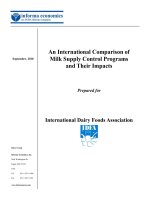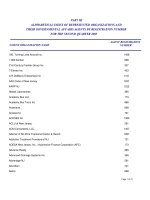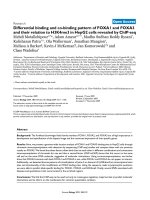Diversity of aphid pests (Homoptera: Aphididae) and their natural bio-control agents in vegetable crop ecosystems of Jammu & Kashmir, India
Bạn đang xem bản rút gọn của tài liệu. Xem và tải ngay bản đầy đủ của tài liệu tại đây (711.14 KB, 18 trang )
Int.J.Curr.Microbiol.App.Sci (2020) 9(5): 2529-2546
International Journal of Current Microbiology and Applied Sciences
ISSN: 2319-7706 Volume 9 Number 5 (2020)
Journal homepage:
Original Research Article
/>
Diversity of Aphid Pests (Homoptera: Aphididae) and their
Natural Bio-Control Agents in Vegetable Crop Ecosystems of
Jammu & Kashmir, India
Deen Mohd. Bhat1*, Sajad Ahmad Khan2, Fayaz Ahmad Ahanger3
and Muzafar Ahmad Sheikh1
1
Department of Zoology, Govt. Degree College Ganderbal, J&K-191201, India
Department of Zoology, Baba Gulam Shah Badshah University, Rajouri, J&K- India
3
Department of Zoology, Govt. College for Women, M. A. Road, Srinagar, J&K-190006, India
2
*Corresponding author
ABSTRACT
Keywords
Aphidiinae, Aphids,
Coccinellidae,
Jammu & Kashmir,
Parasitoids,
Predators
Article Info
Accepted:
18 April 2020
Available Online:
10 May 2020
The aphids (Homoptera: Aphididae) are one of major pests of agriculturally important
crops, including vegetables, across the world. They suck plant sap, cause leaf curling,
yellowing and stunted growth of the host plants. They also act as vectors of many viral
diseases in plants. In order to explore aphid pests and their naturally occurring bio-control
agents (parasitoids and predators), an extensive field survey was conducted in different
vegetable ecosystems of the Kashmir valley during the years from 2014-2019. Moreover, a
through literature survey pertaining to aphids, reported from Jammu and Kashmir, was
also done. Accordingly, based on these studies, it was concluded that as many as 18
species of aphids belonging to 12 genera infest as many as 26 species and 30 varieties of
vegetable crops in Jammu and Kashmir (J&K). It was also concluded that at least 29
species of insect predators and 17 species of parasitoids occur naturally to suppress these
aphid pest species in vegetable ecosystems in J&K. In sum, through this study, a
comprehensive account of aphids and their natural enemies with reference to vegetable
crops in J&K is presented. This work will be useful for the studies concerning the devising
of strategies for Integrated Control Program of aphids, especially through utilization of
natural bio-control agents.
Introduction
Aphids or ‘plant lice’ are minute pear-shaped,
soft-bodied organisms. They belong to Class
Insecta, order Homoptera and family
Aphididae. They may be winged (alate) or
wingless (apterous). Their life cycle is
completed through egg, nymphal and adult
stages. Apart from sexual reproduction, they
can also reproduce through a process of
parthenogenesis (Dixon, 1987 and 1998).
Aphids are an important group of plant insect
pests having a high biotic potential as
reflected by their parthenogenicity, viviparity
2529
Int.J.Curr.Microbiol.App.Sci (2020) 9(5): 2529-2546
and fast development. They are found to
inflict direct (sucking) and indirect
(transmission of viruses and honeydew
secretion) damage to different types of
vegetations and are considered the most
potent and worldwide enemies of many crops
(Blackmon and Eastop, 2007).
Aphids are an extremely successful group
which occurs throughout the world, with the
greatest number of species in the temperate
regions (Blackmon and Eastop, 2007). Out of
4702 aphid species so far known world over
(Remaudiere and Remaudiere, 1997), about
1015 species occur in Oriental region
(Agarwala and Gosh, 1984 ), among which,
about 750 species belonging to 208 genera
represent Indian Aphididae (Gosh and Gosh,
2006).
In Jammu and Kashmir region (India), more
than 31 species of aphids have been reported
on wide range of host-crop species of
agricultural,
horticultural
and
forest
ecosystems, with varying degree of host
specificity (Bhagat, 2012). Among these
aphids, some species had earlier been reported
on vegetable crops and the significant
studies in this regard have been conducted by
Ahmad and Bhat (1986); Bhagat (1986,
2012); Zaz (2001); Pandey et al., (2006);
Bhat (2008, 2017); Khan et al., (2009, 2017);
Bhat et al., (2011); Bhat and Bhagat (2017)
and Bhat and Ahanger (2018).
population in vegetable ecosystems in J&K
region and the key researchs in this regard
were conducted by Rao et al., (1969);
Shujauddin (1973); Stary and Bhagat (1978);
Takada & Rishi (1980); Bhagat (1982 a,
1982b, 1986, 2008); Bhagat & Ahmad
(1991); Bhat (2008a), Khan et al., (2017) and
Bhat et al., (2017).
However, all the aforementioned studies
pertaining to aphids and their natural enemies
in J&K were scattered in different journals
and, hitherto, there was no consolidated
checklist available concerning aphids and
their natural enemies on vegetable crops in
J&K. Therefore, in sum, this paper by way of
adding new information and consolidating the
previous works pertaining to aphids and their
natural enemies, gives a clearer picture
regarding this subject area. Accordingly, a
comprehensive account of the systematic
position, host-crop range and natural biocontrol agents of 18 species of aphids along
with their 45 species of natural enemies
(parasitoids and predators) in J&K is provided
through this work. This study will be helpful
in future for understanding of biodiversity of
aphis and their natural enemies, particularly
from this region. Moreover it would also be
useful for the studies concerning the devising
of strategies of integrated control program for
aphids, especially through utilization of
natural enemies (as bio-control agents).
Materials and Methods
Some natural enemies (parasitoids/predators)
had earlier been reported on aphid pests on
some vegetable crops in J&K region and the
important studies in this connection were
done by Ahmad and Bhat (1986); Bhagat and
Lone (1984); Bhagat & Masoodi (1986); Bali
(1987); Bhagat & Matta (2002); Bhat (2008a)
; Khan et al., (2009, 2017); Shah and Khan
(2013); Bhat (2017) and Bhat & Bhagat
(2017). Similarly, some parasitoid species
were earlier recorded to suppress the aphid
Literature survey and preparation of
compendium/checklist of aphid pests
A comprehensive literature survey of all the
available published works/ research papers
etc., published from time to time pertaining to
aphid pest and their natural bio-control agents
(parasites and predators) in J&K regions, was
done in order to collect the information.
Besides consulting previous published papers,
2530
Int.J.Curr.Microbiol.App.Sci (2020) 9(5): 2529-2546
the other vital e-resources and abstracting
services, particularly, CAB, NISCAIR, AGRI,
Biological abstracts, etc., were also consulted
for obtaining the required information.
development of their adults and for the
recovery of their parasitoids. The adults of
aphids, their parasitoids and predators which
emerged after rearing were identified and
preserved.
Field and laboratory studies
The data presented in this paper is also based
on extensive field surveys of aphids and their
natural bio-control agents(parasites and
predators), in different vegetable farms,
floating gardens, kitchen gardens etc in
different localities of J&K region, conducted
by the present authors over the years from
2007-2019, appended as under:Study area (Fig. 62)
Presentation of data in the form of
checklist
The necessary data, pertaining to aphid is
documented and presented in this paper in the
form of checklist. The aphid species are
listed sub family-wise & systematically, with
details given on their host-plant range
(followed by references), insect predators
(family wise and followed by references) and
parasitoids (followed by references).
Regular fortnightly random and extensive
field surveys were conducted at 7study sites
across the length and breadth of Kashmir
Valley viz. Danderkhah in District Srinagar
(34.0687° N, 74.7783° E), Zazuna in District
Ganderbal (34.2301° N, 74.6854° E), Bugam
in District Budgam (33.6911° N, 75.0231° E),
Bangidar in District Anantnag (33.7265° N,
75.1443° E), Chaklu in District Baramulla
(34.2004° N, 74.3969° E), Sumlar in District
Bandipora (34.4111° N, 74.7235° E) and
Murran in District Pulwama (33.8664° N,
74.8639° E).
Results and Discussion
Sampling method and rearing
The checklist also reveals that at least 29
species of insect predators (natural enemies)
(See Section c), belonging to 25 genera under
5 families (Anthocoridae, Coccinellidae,
Ceccidomyiidae, Syrphidae, Chrysoperlidae)
under 4 Insect orders (Coleptera, Hemiptera,
Diptera Neruoptera) commonly occur and
feed on afore-mentioned aphid species. Apart
from this, 17 species of parastioids
(Hymenoptera: Braconidae: aphidiinae) (See
Section d), belonging to 7 genera which
parasitize these aphids on vegetable crops,
have been documented in this checklist.
The vegetable farms/ vegetable gardens/
kitchen gardens in above cited study areas
were surveyed. Three fields at every site were
selected randomly and sampling procedure
was based on standardized sampling
techniques. The field data regarding aphid
pests, their host-plant, predators (natural
enemy) was recorded in field diary. The
immature stages (nymphs) of aphids were
taken to laboratory, along with predatory
larvae, if any and were reared on the host
plant in glass / plastic jars for the
The results obtained during this work are
highlighted through a below mentioned
checklist,
well
supported
by
field
photography (Fig. 1-61) and table 1. The
checklist reveals that as many as 18 species of
aphids (See Section b) belonging to12 genera
under 2 subfamilies (Aphidiinae and
Lachinae) of family Aphididae (Order:
Homoptera) infest at least 26 species and 30
varieties of vegetable crops (See Section a) in
J&K.
2531
Int.J.Curr.Microbiol.App.Sci (2020) 9(5): 2529-2546
Summary of vegetable plant host-range of
aphid pests in J&K
As highlighted above, 26 species and 30
varieties of vegetable crops (both cultivated
and wild) have been found infested by Aphid
pests. These vegetable plants are: Brassica
napus (Linn.) (= Brassica campestris L.),
Brassica juncea Linn., Brassica napus
(Linn.), Brassica oleracea (Linn.)- Brassica
oleracea var. acephella (kale), Brassica o.
var. botrytis (Cauliflower), B. oleracea var.
capitata (cabbage), B. o.var. kashmiriana, B.
o. var. gongylodes (knolkhol),
Brassica
rapa L. (turnip),
Capcicum annuum L.
(capsicum),
Coriandrum sativum L.
(Corriander), Cucumis sativus (Linn.)
(Cucumber), Cucurbita maxima Duchensc
(large
pumpkin),
Cucurbita
pepo L.
(Marrow), Daucus carota L. (carrot),
Dolichos lablab L. (Lablab bean), Helianthus
tuberosus L.
(artichoke),
Hibiscus
esculentus L
(Okra),
Lagenaria
siceraria (Molina)
(bottle
gourd),
Lycopersicon esculentum Mill (tomato),
Phaseolus coccineus (Linn.) (runner bean),
Phaseolus vulgaris (common bean/French
beans), Pisum sativum Linn. (pea), Raphanus
sativus L. (radish), Rumex acetosa (Linn.),
Rumex nepalensis Spreng Rumix sp. (rumex),
Solanum tuberosum (Linn.), Solanum
melongena L., Taraxacum officinale (L.).
Summary of aphid pest species of vegetable
crops in J&K
The 18 species of Aphids (Family Aphididae)
belonging to 12 genera, which have been
reported to infest vegetable crops in J&K are:
Aphis craccivora Koch, Aphis fabae solanella
Theobald, Aphis gossypii Glover, Aphis
rumicis Linnaeus, Aphis spiraecola (Patch),
Acyrthosiphon pisum Harris, Aulacorthum
solani (Kaltenbach), Brachycaudus helichrysi
(Kaltenbach), Brachycaudus rumexicolens
(Patch), Brevicoryne brassicae (Linnaeus),
Cavariella aegopodii Scopoli, Hyadaphis
coriandri (Das), Lipaphis (Lip.) erysimi
(Kaltenbach),
Lipaphis pseudobrassicae
(Davis),
Myzus
persicae
(Sulzer),
Macrosiphum
euphorbiae
(Thomas),
Semiaphis heraclei (Takahashi), Protrama
penecaea Stryon
Summary of insect predator species
(natural bio-control agents) of aphid pests
on vegetable crops in J&K
The 29 species of insect predators distributed
over 25 genera, which have been reported on
aphid pests in vegetable ecosystems in J&K,
include 12 species of Coccinellidae
(Coleoptera), 10 species of Syrphidae
(Diptera), 2 species of Cecidomyiidae
(Diptera), 3 Species of Chrysoperilidae
(Neuroptera) and 2 species of Anthocoridae
(Hemiptera) and are highlighted as under:Order-coeloptera (family coccinellidae)
Adalia tetraspilota (Hope), Calvia punctata
(Mul.), Coccinella septempunctata L.,
Coccinella
undecempunctata Linnaeus,
Cheilomenes
sexmaculatus Fabricius,
Hippodamia
variegata
(Goe.),
Harmonia dimidiata (Fabricius),
Oenopia
conglobata
(Goe.),
Platynaspidius
saundersi (Crotch) (= Platynaspis saundersi),
Priscibrumus
uropygialis
(=Exochomus
uropygialis)
(Mulsant),
Propylea
luteopustulata (Mulsant), Scymnus sp.
Order-diptera (family syrphidae)
Betasyrphus
serarius
(Wiedemann),
Episyrphus
balteatus DeGeer,
Eupeodes (Macrosyrphus) confrater (Wiedem
ann),
Ischiodon
scutellaris (Fabricius),
Melanostoma
univitatum (Wiedemann),
Metasyrphus corolla (Fabr.), Paragus tibialis
(Fallén,
1817),
Sphaerophoria
scripta (Linnaeus), Syrphus confractor Weid,
2532
Int.J.Curr.Microbiol.App.Sci (2020) 9(5): 2529-2546
(=Metasyrphus confractor), Syrphus sp.,
Order- diptera (family cecidomyiidae)
Aphidoletes aphidimyza (Rondani), Leucopis
sp.
checklist. The Aphid species in this checklist
are
documented
subfamily-wise,
&
systematically, with details given on their
host-plant range (followed by references),
insect predators (family wise and followed by
references) and parasitoids (followed by
references).
Order- Hemiptera (Anthocoridae): Anthocoris
sp., Orius sp.
Sub-family: aphidinae
Order-neuroptera (family chrysopidae)
Tribe-aphidini Latreille, 1802
Chrysoperla zastrowi Sillemi (EsbenPetersen), Chrysoperla (=Chrysopa) carnea
Stephens,
Chrysoperla (=Chrysopa)
orestes Banks
Aphis craccivora koch, 1854
Summary of parasitoid species (natural
bio-control agents) of aphid pests on
vegetable crops in J&K region
Host vegetable plants in J&K/ references
The 17 species of aphid parasitoids
(Hymenoptera: Braconidae: Aphidiinae)
belonging to 7 genera reported on aphid pests
of vegetable crops in J&K are: Aphidius
colemani
Viereck,
Aphidius
eglanteriae Haliday, Aphidius matricariae
Haliday, Aphidius salicis Haliday, Aphidius
smithi Sharma and Subbarao, Aphidius sp.,
Diaeretiella rapae (McIntosh), Ephedrus
persicae Froggatt, Ephedrus plagiator (Nees),
Lysaphidus
erysimi
Stray,
Lysiphlebus(Phelbus)
fabarum (Marshall),
Toxares
zakai
Shujauddin,
Trioxys
kahmirensis
(Takada),
Trioxys (Binodoxys) jaii, Bhagat, Trioxys
(Binodoxys) indicus, Trioxys rubicola
Shujauddin, Trioxys (Trioxys) complanatus
Quilis
Check list of family aphididae on vegetable
crops in J&K
The 18 species of Aphids (Family Aphididae),
which have been reported on vegetable crops
in J&K are appended in the following
Aphis craccivora is commonly known as cow
pea aphid.
Cucumis
sativus,
Dolichos
lablab,
Lycopersicum
esculentum,
Phaseolus
vulgaris, Rumex acetosa, Rumex nepalensis,
Solanum melongena, Solanum tuberosum /
(Bhagat, 2012; Bhat, 2017; Bhat and Bhagat,
2017; Khan et al., 2017; Bhat and Ahanger,
2018)
Predatory
references
natural
enemies
in
J&K/
Coleoptera (Coccinellidae)
Adalia
tetraspilota,
Cheilomenes
sexmaculata,
Hippodamia
variegata,
Platynaspidius saundersi (= Platynaspis
saundersi), Scymnus sp., Oenopia conglobata,
Propylea luteopustulata;
Diptera (Syrphidae)
Eupeodes
(Macrosyrphus)
confrater,
Ischiodon
scutellaris,
Melanostoma
univitatum, Sphaerophoria scripta, Paragus
tibialis / (Bhat, 2017; Khan et al., 2017; Bhat
and Bhagat, 2017)
2533
Int.J.Curr.Microbiol.App.Sci (2020) 9(5): 2529-2546
Parasitoid
references
natural
enemies
in
J&K/
(Hymenoptera: Braconidae: Aphidiinae):
Diaeretiella rapae / (Bhagat & Ahmad, 1991;
Bhagat, 2008); Trioxys (Binodoxys) indicus /
(Bhagat, 2008), Ephedrus persicae Froggatt,
Trioxys jaii Bhagat/ (Stary and Bhagat, 1978;
Bhagat, 1982 a, 1982b; Khan et al., 2017)
Host vegetable plants in J&K/ references
Capsicum annum, Cucumis sativus, Cucurbita
maxima, Cucurbita pepo,
Lagenaria
siceraria, Rumex sp., Solanum melongena, S.
tuberosum, Taraxacum officinale (Bhagat
and Masoodi, 1986; Bhat et al., 2011; Khan
et al., 2017; Bhat,2017 ; Bhat and Bhagat,
2017; Bhat & Ahanger, 2018).
Aphis fabae solanella Theobald, 1914
Predatory
references
It is commonly known as Black bean aphid.
Coeloptera (Coccinellidae)
Host vegetable plants in J&K/ references
Adalia tetraspilota (Hope), Coccinella
septempunctata
L.,
Cheilomenes
sexmaculatus, Hippodamia variegata (Goe.),
Symnus sp., Priscibrumus uropygialis
(=Exochomus
uropygialis),
Propylea
luteopustulata (Mulsant);
Neuroptera
(Chrysopidae): Chrysoperla sillemi (EsbenPetersen),
Chrysopa
arestes;
Diptera
(Syrphidae): Episyrphus balteatus DeGeer
(Ahmad and Bhat, 1986; Bhat, 2017; Bhat
and Bhagat, 2017; Khan et el., 2017);
Hemiptera (Anthocoridae): Anthocoris sp.,
Orius sp. (new records)
Phaseolus sp. (French beans), Rumex
acetosella, Rumex nepalensis / (Bhat & Lone,
1984; Bhat, 2017; Khan et al., 2017; Bhat and
Ahanger, 2018)
Predatory
references
natural
enemies
in
J&K/
Coleoptera (coccinellidae)
Adalia
tetraspilota,
Coccinella
septempunctata, Chrysoperla z. sillemi,
Hippodamia
dimidiate,
Hippodamia
variegate, Oenopia conglobata (Goe.);
Diptera: (Chamaemyiidae): Aphodoletes
aphidomyzae, Leucopis sp. /(Bhagat and
Lone, 1084; Bhagat and Matta, 2002;
Bhat,2017; Khan et al., 2017); Hemiptera
(Anthocoridae): Anthocoris sp., Orius sp.
Parasitoid
references
natural
enemies
in
J&K/
Parasitoid
references
natural
natural
enemies
enemies
in
in
J&K/
J&K/
(Hymenoptera: Braconidae: Aphidiinae):
Ephedrus plagiator (Nees), Trioxy srubicola
Shujauddin (Rishi, 1976; Shujauddin, 1973;
Khan et al., 2017)
4. Aphis rumicis Linnaeus, 1758
Host vegetable plants in J&K/ references
(Hymenoptera: Braconidae: Aphidiinae):
Aphidius matricariae Haliday (Bhagat and
Ahmad, 1991; Bhat et al., 2017);
Lysiphelebus (Phelbus) fabrum, Trioxys
(Binodoxys) indicus (Bhagat. 2008)
Rumix sp. (Khan et al., 2017)
Natural enemies and authors reporting
Aphis gossypii Glover, 1802
Predatory natural enemies
references
Coeloptera (Coccinellidae)
Aphis gossypii is commonly known as cotton
aphid.
Adalia tetraspilota (Hope), Hippodamia
variegate (Goe.), Propylea luteopustulata
(Mul.) (Khan et al., 2017).
2534
in
J&K/
Int.J.Curr.Microbiol.App.Sci (2020) 9(5): 2529-2546
Parasitoid natural enemies
references: not known
in
J&K/
Episyrphus
balteatus,
Melanostoma
univitatum (Ahmad and Bhat, 1986; Bhat et
al., 2011; Bhat and Bhagat, 2017)
Aphis spiraecola (Patch, 1914)
Aphis spiraecola is commonly known as
spirea aphid.
Cucumis sativus (Khan et al., 2017)
Natural enemies and authors reporting
natural
enemies
in
J&K/
enemies
in
J&K/
Aulacorthum solani (Kaltenbach, 1843)
Host vegetable plants in J&K/ references
Coeloptera (Coccinellidae)
Hibiscus esculentus (Okra) (khan et al., 2017)
Adalia
tetraspilota,
Coccinella
septempunctata, H. dimidiata, Hippodamia
variegata (Goe.); Neuroptera (Chrysopidae):
Chrysoperla z. sillemi (Khan et al., 2017)
Parasitoid
references
natural
(Hymenoptera: Braconidae: Aphidiinae):
Aphidius eglanteriae (Bhagat, 2008);
Aphidius smithi Sharma and Subbarao
(Takada and Rishi, 1980); Trioxys Trioxys
complanatus Quilis (Bhagat, 2008).
Host vegetable plants in J&K/ references
Predatory
references
Parasitoid
references
natural
enemies
in
J&K/
(Hymenoptera: Braconidae: Aphidiinae):
Aphidius matricariae Haliday (Stary and
Bhagat, 1978; Khan et al., 2017)
Tribe-Macrosiphini Wilson, 1910
Predatory
references
natural
enemies
in
J&K/
Coeloptera (Coccinellidae)
Adalia tetraspilota (Hope),
septempunctata,
Hippodamia
(Goe.) (khan et al., 2017).
Coccinella
variegata
Parasitoid
references
in
natural
enemies
J&K/
(Hymenoptera: Braconidae: Aphidiinae):
Aphidius sp. (khan et al., 2017).
Acyrthosiphon pisum Harris, 1776
Brachycaudus
1843)
Host vegetable plants in J&K/ references
helichrysi
(Kaltenbach,
Phaseolus sp., Pisum sativum Linn (Ahmad
and Bhat, 1986; Bhagat, 1986, 2012; Bhat et
al., 2011; Khan et al., 2017; Bhat and
Ahanger, 2018)
Brachycaudus helichrysi is commonly known
as green peach aphid.
Predatory
references
Brassica oleracea (Khan et al., 2017)
natural
enemies
in
J&K/
Predatory
references
Coeloptera (Coccinellidae)
Adalia tetraspilota (Hope),
variegate (Goe.); Diptera
Host vegetable plants in J&K/ references
Hippodamia
(Syrphidae):
natural
enemies
in
J&K/
Coeloptera (Coccinellidae)
Adalia
2535
tetraspilota
(Hope),
Coccinella
Int.J.Curr.Microbiol.App.Sci (2020) 9(5): 2529-2546
septempunctata L., Hippodamia variegata
(Goe.), Propylea luteopustulata; Neuroptera
(Chrysopidae): Chrysoperla sillemi E. & P.
(Khan et al., 2017)
Predatory
references
Parasitoid
references
Adalia tetraspilota (Hope), Cheilomenes
sexmaculata, Coccinella septempunctata,
Hippodamia variegate (Goe.), Propylea
luteopustulata (Mul.); Diptera (Syrphidae):
Episyrphus balteatus, Sphaerophoria scripta
(Bhgat and Lone, 1984; Ahmad and Bhat,
1986; Khan et al., 2009,2017; Bhat, 2017;
Bhat and Bhagat, 2017; Khan et al., 2017)
natural
enemies
in
J&K/
(Hymenoptera: Braconidae: Aphidiinae):
Aphidius matricariae Haliday (Khan et al.,
2017)
Brachycaudus rumexicolens (Patch, 1917)
Host vegetable plants in J&K/ references
natural
enemies
in
J&K/
Coeloptera (Coccinellidae)
Parasitoid
references
natural
enemies
in
J&K/
Rumex sp. (Khan et al., 2017)
Predatory
references
natural
enemies
in
J&K/
Coeloptera (Coccinellidae)
Adalia tetraspilota, Calvia punctata (Mul.),
Hippodamia variegata (Goe.); Neuroptera
(Chrysopidae): Chrysoperla sillemi E. & P.
(Khan et al., 2017)
Parasitoid natural enemies
references: not known
in
J&K/
Brevicoryne brassicae (Linnaeus, 1758)
(Hymenoptera: Braconidae: Aphidiinae):
Aphidius matricariae Haliday, Diaeretiella
rapae (M’Int) (Rao et al., 1969; Bhagat and
Amad, 1991; Stary & Bhagat, 1978; Bhagat,
1986; Bhat, 2008; Bhat et al., 2017; Bhagat
and Ahmad, 1991)
Cavariella aegopodii Scopoli 1763
Host vegetable plants in J&K/ references
Daucus carota (Bhat, 2017; Bhat and
Ahanger, 2018)
Predatory
references
It is commonly known as cabbage aphid.
Host vegetable plants in J&K/ references
Brassica oleracea (Linn.), Brassica oleracea
var. acephella, Brassica o. var. botrytis, B.
oleracea var. capitata, B. o.var. kashmiriana,
Brassica oleracea var. gongylodes (Ahmad
and Bhat, 1986; Bhagat, 1986, 2012; Zaz,
2001; Pandey et al., 2006; Khan et al., 2009,
2017; Bhat et al., 2011; Bhat, 2017; Bhat &
Bhagat, 2017; Bhat and Ahanger 2018).
natural
enemies
in
J&K/
Diptera (Syrphidae): Episyrphus balteatus
(Bhat and Bhagat, 2017)
Parasitoid natural enemies in J&K/
references: Not known
Hyadaphis coriandri (Das, 1918)
Host vegetable plants in J&K/ references
Coriandrum sativum (Corriander) (Khan et
al., 2017)
2536
Int.J.Curr.Microbiol.App.Sci (2020) 9(5): 2529-2546
Predatory
references
natural
enemies
in
J&K/
Coeloptera (Coccinellidae)
Adalia tetraspilota (Hope), Calvia punctata
(Mul.), Coccinella septempunctata L,
Hippodamia variegata (Goe.); Neuroptera
(Chrysopidae): Chrysoperla z. sillemi E. & P.
(Khan et al., 2017)
Parasitoid
references
natural
enemies
in
J&K/
(Hymenoptera: Braconidae: Aphidiinae):
Diaertiella rapae (Rao et al., 1969; Rishi,
1976; Bhagat, 1986; Bhagat and Ahmad, 199;
Bhat et al., 2017)
Lipaphis pseudobrassicae (Davis, 1914)
Host vegetable plants in J&K/ references
Parasitoid
references
natural
enemies
in
J&K/
(Hymenoptera: Braconidae: Aphidiinae):
Aphidius matricariae H. (Khan et al., 2017)
Brassica oleracea Brassica juncaea Brassica
oleracea var capitata, B. rapa, Raphanus
sativa (Khan et al., 2017)
Predatory natural enemies in J&K/
references: Coeloptera (Coccinellidae):
Lipaphis (Lip.) erysimi (Kaltenbach, 1843)
Host vegetable plants in J&K/ references
Brassica napus (Linn.) (= Brassica
campestris L.),
Brassica campestris),
Brassica napus (Bhagat, 1986; Bhat et al.,
2011; Bhagat, 2012; Bhat and Ahanger,
2018)
Predatory natural enemies in J&K/
references: Coeloptera (Coccinellidae)
Adalia tetraspilota (Hope), Calvia punctata,
Cheilomenes
sexmaculata,
Coccinella
septempunctata
L.,
Coccinella
undecempunctata, Hippodamia variegate
(Goe.), Oenopia congoblata;
Diptera
(Syrphidae):
Sphaerophoria
scripta,
Melanostoma
univitiatum,
Ischiodon
scutellaris,
Metasyrphuscorolae,
Metasyrphus confractor, Paragus seratus,
Betasyrphus serarius, Syrphus sp. (Bhagat
and Lone, 1984; Ahmad and Bhat, 1986; Bali,
1987; Bhagat and Matta, 2002; Khan et al.,
2009; Bhat, 2017; Bhat and Bhagat, 2017)
Adalia tetraspilota (Hope), Coccinella
septempunctata L., Propylea luteopustulata
(M.),
Hippodamia
variegate
(Goe.);
Neuroptera (Chrysopidae):
Chrysoperla
sillemi E.& P. (Khan et al., 2017)
Parasitoid
references
natural
enemies
in
J&K/
(Hymenoptera: Braconidae: Aphidiinae):
Lysaphidus erysimi Stray (Khan et al., 2017)
Myzus persicae (Sulzer, 1762)
Myzus persicae is commonly known as green
peach aphid.
Host vegetable plants in J&K/ references
Capcicum annuum, Cucurbita maxima
Lycopersicon
esculentum
Solanum
melongena, Solanum tuberosum (Bhat, et al.,
2011; Bhagat, 2012; Khan et al., 2017; Bhat
and Ahanger, 2018)
2537
Int.J.Curr.Microbiol.App.Sci (2020) 9(5): 2529-2546
Predatory
references
natural
enemies
in
J&K/
Coeleoptera (Coccinellidae)
Adalia tetraspilota (Hope), Cheilomenes
sexmaculata, Coccinella septumpunctata,
Hippodamia variegate (Goe.), Propylea
luteopustulata (Mul.), Scymnus sp.; Diptera
(Syrphidae): Episyrphus balteatus (Bhat,
2017; Bhat and Bhagat, 2017; Khan et al.,
2017); Hemiptera (Anthocoridae): Anthocoris
sp., Orius sp. (new record) ; Neuroptera
(Chrysopidae):
Chrysopa (Chrysoperla
carnea) Stephens (Bhat, 2008a)
Parasitoid
references
natural
enemies
in
Parasitoid
references
natural
enemies
in
J&K/
(Hymenoptera: Braconidae: Aphidiinae):
Trioxys kahmirensis (Takada) (Takada and
Rishi, 1980; khan et al., 2017)
Semiaphis heraclei (Takahashi, 1921)
Host vegetable plants in J&K/ references
Daucus carota (Bhagat, 1986, 2012; Bhat and
Ahanger,2018)
Predatory natural enemies in J&K/ references:
Not known
J&K/
Parasitoid
references
(Hymenoptera: Braconidae: Aphidiinae):
Aphidius matricariae Haliday (Bhagat, 2008),
Aphidius colemani Viereck, Toxares zakai
Shujauddin (Shujauddin, 1973)
natural
in
J&K/
(Hymenoptera: Braconidae: Aphidiinae):
Aphidius salicis (Bhagat, 1986; Bhagat, 2008)
Sub-family-Lachinae
1854
Macrosiphum euphorbiae (Thomas, 1878)
enemies
Herrich-Schaeffer,
The tribe- Tramini
Host vegetable plants in J&K/ references
Protrama penecaea Stryon 1998
Solanum melongena (khan et al., 2017)
Predatory
references
natural
enemies
in
Host vegetable plants in J&K/ references
J&K/
Helianthus tuberosus (Artichoke) (Khan et
al., 2017)
Coeleoptera (Coccinellidae)
Predatory
references
Adalia tetraspilota (Hope), Coccinella
septempunctata,
Hippodamia
variegata
(Goe.) (khan et al., 2017); Hemiptera
(Anthocoridae): Anthocoris sp. (new record)
Coeleoptera
(Coccinellidae):
Adalia
tetraspilota (Hope), Calvia punctata (Mul.),
Hippodamia variegata (Goe.); Neuroptera
(Chrysopidae): Chrysoperla z. Sillemi E. & P.
(Khan et al., 2017). Parasitoids / references:
Not known.
2538
natural
enemies
in
J&K/
No. of Aphid sub-families (Aphidiine, Lachinae)
No. of Aphid Genera (see sec. b in text)
No. of Aphid species (see sec. b in the text)
No. of Insect predator Orders (Coleoptera, Diptera,
Hemiptera Neuroptera)
No. of Insect predator families (Anthocoridae,
Cecidomyiidae, Chrysoperilidae, Coccinellidae,
Syrphidae,
No. of insect predator Genera (see sec. c in the text)
No. of insect predator species (See Sec. c in the text)
No. of Insect parasitoid orders (Hymenoptera)
No. of insect parasitoid families (Braconidae:
Aphidiinae)
No. of insect parasitoid Genera (see sec. d in the text)
No. of insect parasitoid species (see sec. d in the text)
Int.J.Curr.Microbiol.App.Sci (2020) 9(5): 2529-2546
Table.1 Species richness of Aphids and their natural enemies on vegetable crops in J&K
Aphids
Natural enemies
Predators
Parasitoids
2
10
18
4
5
25
29
1
1
7
17
Legends to Figures (Photo credit Deen Mohd.)
2539
Int.J.Curr.Microbiol.App.Sci (2020) 9(5): 2529-2546
2540
Int.J.Curr.Microbiol.App.Sci (2020) 9(5): 2529-2546
2541
Int.J.Curr.Microbiol.App.Sci (2020) 9(5): 2529-2546
2542
Int.J.Curr.Microbiol.App.Sci (2020) 9(5): 2529-2546
Fig.1-5, 11, 12, 14, 18, 34, 40, 48, 50 Aphid infestations on different vegetable plants in Kashmir
Fig.6, 7, 9, 10, 16, 21, 22, 28, 31, 33, 38, 43, 45, 47, 49, 51 Larvae of coccinellid beetles
(predators) feeding on aphid pests on different vegetable plants in Kashmir
Fig.13, 17, 19, 20, 23, 24, 26, 30, 35, 37 larvae of syrphid flies (predators) feeding on aphid pests
on different vegetable plants in Kashmir
Fig.8, 15, 27, 29, 32, 36, 39, 42 adult coccinellid beetles (predators) feeding on aphid pests on
different vegetable plants in Kashmir
Fig.25 larva of Chrysoperla feeding on aphids in vegetable fields in Kashmir
Fig.51 Predatory bug Anthocoris sp. recovered from vegetable fields while feeding on aphids in
Kashmir
Fig.53 Parasitoid Trioxys sp. recovered from aphids in Kashmir
Fig.54-55 Parasitoid D. rapae recovered from aphid B. brassicae in Kashmir
Fig.57 Adult syrphid fly Metasyrphus sp. (Syrphidae), predator of aphids, collected after rearing
of its larvae in Kashmir
Fig.60 Adult Chrysoperla recovered after rearing of its larvae on aphids in Kashmir
2543
Int.J.Curr.Microbiol.App.Sci (2020) 9(5): 2529-2546
Fig.61 Adult syrphid fly Sphaerophoria scripta, predator of aphids, collected after rearing of its
larvae in Kashmir
Fig.62 Map of J&K showing study areas (Districts) in Kashmir
Since, the complete knowledge of aphids is
crucial for understanding their pest nature and
for formulating a proper control and
management strategy in order to mitigate their
damage on vegetable crop ecosystems, So, the
present work, based on field and literature
survey provided a base line data pertaining
aphid pests and their natural bio-control
agents in vegetable ecosystems in J&K. Based
on this work, it is understood that there are
large number of aphid species (at least 18)
which attack various types of vegetable crops
in this region.
However there are even more diverse kinds of
natural bio-control agents of these aphid pests
represented by 17 species of parasitoids and
29 species of predators, which mitigate the
damage caused by aphids in vegetable
ecosystems of this region.
2544
Int.J.Curr.Microbiol.App.Sci (2020) 9(5): 2529-2546
Thus, it is concluded that it is important to
preserve and conserve the existing diversity
of such natural enemies so that efforts of
integrated control program, if planned for
vegetable crop ecosystems in this region, can
materialize and be successful.
References
Agarwala BK and Ghosh AK. 1984. A checklist
of Aphidoidea (Homoptera) of India.
Records of Zoological Survey of India.
50: 73.
Ahmad D and Bhat MR. 1986. Distribution and
host range of some aphidophagous
Syrphid flies in Kashmir. Geobios New
Reports. 5: 165-166.
Bali R. 1987. Coccinellids (Coleoptera) of
Kashmir Valley, distribution and host
range. Geobios New Reports. 6: 187-89.
Bhagat KC and Masoodi MA. 1986. Record of
green lacewing fly, Chrysopa arestes
Banks (Chrysopidae: Neuroptera) as a
predator of brinjal aphid, Aphis gossypii
Glover (Aphididae: Homoptera). Indian
Journal of Plant Protection. 13(2): 132.
Bhagat RC and Ahmad MN. 1991. Aphidiid
parasitoids (Hymenoptera) of Aphids
(Homoptera) of Jammu-new records, host
range and biological notes. Journal of
Aphidology. 5: 90-96.
Bhagat RC and Lone MA. 1984. New records
and host range of predators of aphids
(Aphididae: Homoptera) in Kashmir
Valley, India. Science and Culture.
50(12):333-372
Bhagat RC and Matta A. 2002. Host range and
diversity of aphidophagous insect
(predators) of Kashmir Himalaya, with
new host aphid/plant records, In: Khan,
M. A. (Ed.). Environment Biodiversity
and Conservation. A. P.H. Pub. New
Delhi. Pp. 269-282
Bhagat RC. 1982a. New aphid parasitoids
(Hymenoptera: Aphidiiae) from Kashmir,
India. Oriental Insects. 16:113-117.
Bhagat RC. 1982b. On two new parasitoids
(Hymenoptera Aphidiiae) from Kashmir.
Entomon. 7(3):321-324
Bhagat RC. 1986. On aphid pests and their
aphidoid parasitoids of agricultural
importance. Indian Agriculturists. 30 (3):
229-235
Bhagat RC. 2008. Biodiversity of parasite-fauna
of Jammu, Kashmir and Ladakh.
Paramount Publishing Corporation, New
Delhi. Pp. 232
Bhagat RC. 2012. Aphids (Insecta) of
agricultural importance in J&K state,
India: a checklist and biodiversity.
International Journal of
Food,
Agriculture and Veterinary Science. 2(3):
116-125.
Bhat DM and Ahanger FA. 2018. A systematic
checklist and species richness of insect
pests associated with vegetable crops in
Jammu & Kashmir State (India). Journal
of Entomology and Zoology studies 6
(2): 328-338
Bhat DM and Bhagat RC. 2017. Host Range
and Diversity of Syrphid Predators
(Insecta: Diptera) of aphids on Vegetable
Crops of Kashmir, with New Host Aphid/
Plant Records. Trends in Bioscinces.
10(6): 1446-1448
Bhat DM, Bhagat RC and Qureshi AA. 2011. A
survey of insect pests damaging
vegetables crops on Kashmir valley
(India), with some new records. Journal
of Entomological Reserach. 35(1):85-91.
Bhat DM, Bhagat RC and Qureshi AA. 2017.
Parasitoid fauna associated with insect
pests of vegetable crops of Kashmir
Himalaya, India: check list and
biodiversity. Munis Entomology and
Zoology. 12(1): 168-174
Bhat DM. 2008a. Studies on insect parasites
and predators of some insect pests of
vegetable crops of Kashmir Valley. Ph.D
thesis, P.G. Department of Zoology,
University of Kashmir, Srinagar, J&K
(India).
Bhat DM. 2017. Host range and diversity of
Coccinellid (Coleoptera) predators of
aphid pests in vegetable crop ecosystems
of Kashmir, with new host aphid/plant
2545
Int.J.Curr.Microbiol.App.Sci (2020) 9(5): 2529-2546
records. Journal of Entomological
Research. 41 (2): 183-186
Bhat MA. 2008. A report on insect pests
associated with Cole crops in Kashmir.
Applied Biological Research. 10:66-67
Blackman RL and Eastop VF. 2006. Aphids on
the World’s Herbaceous Plants and
Shrubs. Wiley, Chichester. Pp. 1024
Blackman RL and Eastop VF. 2007. Taxonomic
Issues. In: Aphids as Crop Pests. (Eds.
H.F. van Emden and R. Harrington),
CABI, Cambridge, UK. Pp. 1-22
Dixon
AFG.
1987.
Parthenogenetic
reproduction and the rate of increase in
aphids. In: Aphids; their Biology, Natural
Enemies and Control, (Eds. A.K. Minks
and P. Harrewijin), Elsevier, Amsterdam.
Pp. 269-287
Dixon AFG. 1998. Aphid Ecology, 2nd edn.,
Chapman and Hall, London. Pp. 300
Ghosh AK and Ghosh LK. 2006. The Fauna of
India
and
Adjacent
Countries:
Homoptera,
Aphidoidea,
Zooogical
Survey of India, Calcutta.7 (1): 244.
Khan AA, Shah MA and Riyaz S. 2017.
Records of aphid and their natural
enemies in agro-ecosystem with special
reference to horticultural ecosystem of
Kashmir. Journal of Entomology and
Zoology Studies. 5(4): 189-203
Khan AA, Zaki FA, Khan ZH and Mir MA.
2009. Biodiversity of predaceous beetles
(Coleoptera: Coccinellidae) in Kashmir.
Journal of Biological Control. 23: 43-47.
Pandey AK, Namgyal D, Mehdi M, Mir MS
and Shiekh BA. 2006. A case study:
Major insect pests associated with
different vegetable crops in cold and
region Ladakh, of Jammu and Kashmir.
Journal of Entomological Research.
30(2):169-174
Rao VP, Ramaseshiah G, Sethumadhavan TV
and Ramaswamy P. 1969. Study of
natural enemies of aphids (for the U. S.
A.). Report of the Commonwealth
Institute of Biological Control. Pp: 45-47.
Remaudiere G and Remaudiere M. 1997.
Catalogue of World’s Aphididae:
Homoptera- Aphidoidea. Inra Edition,
Route de France. Pp. 478
Shah MA and Khan AA. 2013. Aphid in
agroecosystem and their management. In:
Hill Agriculture: Prospects, Constraints
and Mitigations, edited by Dr. Shahid
Ahamad, Daya Publishing House, New
Delhi. Pp. 314-330
Shah MA, Khan AA, Junaid JM, Majid S and
Mohi-ud-din S. 2015. Aphid Vectored
Viral Diseases and their Management. In:
Insect Pests Management of Fruit Crops,
Edited by Ajay Kumar Pandey, Dr.
Pramod Mall, paper 27, Biotech Books,
Ansari Road, Darya Ganj, New Delhi. Pp.
511-554.
Shujauddin. 1973. Three species of Trioys
Haliday (Hymenoptera Aphidiiae) from
India. Indian Journal of Entomology. 35:
9-14
Stary P and Bhagat RC. 1978. Records and
descriptions of aphid parasitoids from
Kashmir,
India
(Hymenoptera:
Aphidiidae).
Acta
Entmologica
Bohemoslov. 75: 387-393
Takada H and Rishi ND. 1980. Records of
fifteen
species
of
Aphidiiae
(Hymenoptera) from Kashmir, India with
descriptions of three new species. Kontyu.
48:234240.
Zaz GM. 2001. Incidence and population buildup of cabbage aphid, Brevicoryne
brassicae on cabbage and cauliflower.
Applied Biological Research. 3 (1 & 2):
51-53
How to cite this article:
Deen Mohd. Bhat, Sajad Ahmad Khan, Fayaz Ahmad Ahanger and Muzafar Ahmad Sheikh.
2020. Diversity of Aphid Pests (Homoptera: Aphididae) and their Natural Bio-Control Agents
in Vegetable Crop Ecosystems of Jammu & Kashmir, (India). Int.J.Curr.Microbiol.App.Sci.
9(05): 2529-2546. doi: />2546









